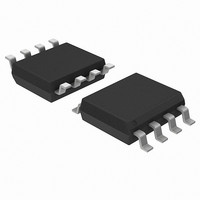SST25VF020B-80-4C-SAE-T Microchip Technology, SST25VF020B-80-4C-SAE-T Datasheet - Page 22

SST25VF020B-80-4C-SAE-T
Manufacturer Part Number
SST25VF020B-80-4C-SAE-T
Description
2.7V To 3.6V 2Mbit SPI Serial Flash 8 SOIC 3.90mm (.150") T/R
Manufacturer
Microchip Technology
Datasheet
1.SST25VF020B-80-4C-SAE.pdf
(35 pages)
Specifications of SST25VF020B-80-4C-SAE-T
Format - Memory
FLASH
Memory Type
FLASH
Memory Size
2M (256K x 8)
Speed
80MHz
Interface
SPI Serial
Voltage - Supply
2.7 V ~ 3.6 V
Operating Temperature
0°C ~ 70°C
Package / Case
8-SOIC (0.154", 3.90mm Width)
Lead Free Status / RoHS Status
Lead free / RoHS Compliant
A Microchip Technology Company
©2011 Silicon Storage Technology, Inc.
Write-Status-Register (WRSR)
The Write-Status-Register instruction writes new values to the BP1, BP0, and BPL bits of the status
register. CE# must be driven low before the command sequence of the WRSR instruction is entered
and driven high before the WRSR instruction is executed. See Figure 20 for EWSR or WREN and
WRSR for byte-data input sequences.
Executing the Write-Status-Register instruction will be ignored when WP# is low and BPL bit is set to
“1”. When the WP# is low, the BPL bit can only be set from “0” to “1” to lock-down the status register,
but cannot be reset from “1” to “0”. When WP# is high, the lock-down function of the BPL bit is disabled
and the BPL, BP0, and BP1 bits in the status register can all be changed. As long as BPL bit is set to 0
or WP# pin is driven high (V
instruction, the bits in the status register can all be altered by the WRSR instruction. In this case, a sin-
gle WRSR instruction can set the BPL bit to “1” to lock down the status register as well as altering the
BP0, BP1, and BP2 bits at the same time. See Table 2 for a summary description of WP# and BPL
functions.
Figure 20:Enable-Write-Status-Register (EWSR) or Write-Enable (WREN) and
The Write-Status-Register instruction also writes new values to the Status Register 1. To write values
to Status Register 1, the WRSR sequence needs a word-data input—the first byte being the Status
Register bits, followed by the second byte Status Register 1 bits. CE# must be driven low before the
command sequence of the WRSR instruction is entered and driven high before the WRSR instruction
is executed. See Figure 21 for EWSR or WREN and WRSR instruction word-data input sequences.
Executing the Write-Status-Register instruction will be ignored when WP# is low and BPL bit is set to
‘1’. When the WP# is low, the BPL bit can only be set from ‘0’ to ‘1’ to lock-down the status registers,
but cannot be reset from ‘1’ to ‘0’. When WP# is high, the lock-down function of the BPL bit is disabled
and the BPL, BP0, BP1, TSP, and BSP bits in the status register can all be changed. As long as BPL
bit is set to 0 or WP# pin is driven high (V
of the WRSR instruction, the bits in the status register can all be altered by the WRSR instruction. In
this case, a single WRSR instruction can set the BPL bit to “1” to lock down the status register as well
as altering the BPL, BP0, BP1, TSP, and BSP bits at the same time. See Table 2 for a summary
description of WP# and BPL functions.
SCK
CE#
SO
SI
MODE 3
MODE 0
Write-Status-Register (WRSR) Byte-Data Input Sequence
0 1 2 3 4 5 6 7
MSB
50 or 06
IH
) prior to the low-to-high transition of the CE# pin at the end of the WRSR
22
IH
) prior to the low-to-high transition of the CE# pin at the end
HIGH IMPEDANCE
MODE 3
MODE 0
MSB
0 1 2 3 4 5 6 7 8 9 10 11 12 13 14 15
2 Mbit SPI Serial Flash
01
MSB
7 6 5 4 3 2 1 0
REGISTER IN
STATUS
SST25VF020B
S71417-03-000
1417 EWSR.0
Data Sheet
02/11












